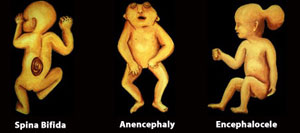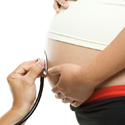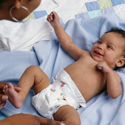Types of NTDs

Spina Bifida
Spina bifida (spi' nah bif' ida) is the most common NTD. It occurs when the spinal column (backbone) fails to close completely during early development. The nerves of the spinal column can be exposed and open to possible damage.
- Spina bifida may cause leg paralysis, bladder and bowel problems and other serious health complications.
- The severity of disability depends on the size and location of the opening on the spine. Usually, the larger defects and those higher on the spine cause more disability.
- Children born with this condition usually need surgery in the first few days of life to close the open spinal area.
- Most people with spina bifida need to use a wheelchair or leg braces throughout their life.
Anencephaly
Anencephaly (an" en-sef' ah-le) is when the brain and skull of the baby do not form properly. Unfortunately, this birth defect is always fatal.
Encephalocele
Encephalocele (en-sef' ah-lo-sēl") is an opening in the skull that allows some of the brain to be outside the skull, covered only with a thin sac or tissue. Encephalocele can result in a range of mental disabilities or may be fatal.

Folate is needed for good health and may help reduce the risk of serious birth defects and some chronic diseases such as heart disease and certain cancers.

